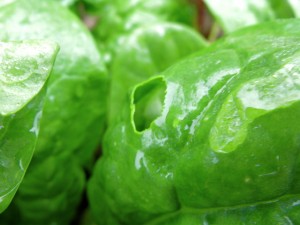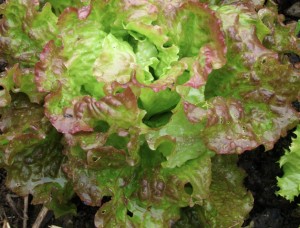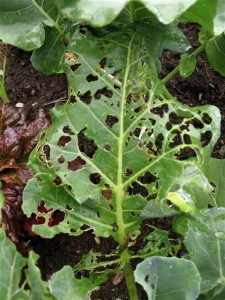Help, my garden has been slimed ! Organic methods for controlling slugs and snails…

S L U G S Â !
If you live in New England like I do, you are more than ready for a dose of sunshine ! The east coast has been having a long stretch of rainy weather this month, creating many wet-weather challenges for vegetable and flower gardeners. One of the most destructive groups of garden pests, slugs and snails, thrive in warm, wet conditions. Slugs over-winter in the garden, and when the ground thaws, they slowly emerge to begin a new life cycle. Slow moving in cool weather, slugs and snails are rarely a problem during early spring in cold climates. But come June, when the temperatures rise and when moisture and leafy greens are abundant, slugs can become devastating. Slugs and snails are usually dormant during hot, dry spells and during the daytime. On warm, humid nights and during rainy periods, these garden pests slither from their cool hiding places beneath the cover of mulch, stones, logs and other spots and begin feeding on our produce and flowers. In a single stretch of rainy nights, slugs can chew holes through row upon row of lettuce, consume entire morning glory vines, ruin a backyard crop of strawberries, and devour beds of vegetable and flower seedlings. Â The tell tale signs of slug damage; shiny trails, the slippery remains of seedlings, and slimy foliage with irregular holes, will be visible the morning after a feeding frenzy. Â Sometimes, when the weather is particularly rainy, slugs can even be spotted feeding in the daytime.
In order to control slugs once they have invaded, a gardener needs to act quickly and remain vigilant. Recognizing minor slug damage, (photos one and two), and responding immediately will save a garden from major destruction and crop loss, (photo three).
Minor slug damage on a leaf of spinach.
Slug damage on a head of lettuce.
Severe slug damage on broccoli.
The most labor-intensive method of slug control is handpicking at night. When done consistently, this is very, very effective. Sometime after nine p.m., grab a flashlight and a pail of soapy water, (wear rubber gloves if you are bothered by slime), and head out into your garden. Starting at ground level, check plants, turning leaves to inspect the undersides as you go. Look through mulch and around the base of plants, and check your compost area and weed baskets too. Collect all the slugs you find and drop them in your pail of soapy water to drown overnight. In the morning, you can dispose of the dead slugs by digging a hole, dumping them and covering them with soil or compost. Â You can also try luring slugs into false-shelters, such as scrap wood propped up by pebbles. Leave these traps out overnight and check them in the morning when slugs will retreat from the sunlight beneath shelters. When checking for slugs during the daytime, look beneath logs, rocks and stones, and in beds of ground-cover such as vinca and ivy.
If slugs are becoming a severe problem in your garden, try pulling mulch back away from plants, and look for slugs and eggs during the daytime. Leave mulch turned over to expose slugs and eggs to sunlight and predators like beetles, frogs, snakes and birds. Be sure to keep your garden tidy. Remove all pulled weeds, garden debris and thinned seedlings to the compost pile. Regularly empty all weeding baskets and be on the look-out for any potential slug-havens, such as the bottoms of flower pots and garden furniture.
Sometimes barriers can be effective in dealing with slugs. Many gardeners find that rough-surfaces are unappealing to snails and slugs, and laying a stretch of pine needles, coffee grounds, crushed shells, sawdust and/or wood shavings around planting beds can be enough to deter them. If you try this, be sure to replace the barrier frequently. Other barrier methods include organic, oily soap products and even copper strips. When the slimy surfaced slugs encounter strips of copper, they are hit with an electric current. This shock isn’t strong enough to kill them, but it has been shown to work as a deterrent. If you garden with raised beds, adding a strip of copper flashing along the top of the wood can be a very effective method for controlling slugs.
Many organic gardeners trap slugs in beer cups as a method of slug control, or as part of an overall plan of attack on these pests. Slugs are attracted to beer or sugar/yeast solutions in water. Â If plastic cups are set into multiple 4-5″ holes dug in the soil around the edge of the garden and filled with an inch or so of beer or yeast solution, slugs will slither in to investigate, consume the liquid, and drown. Â In order for this method to work, a gardener will have to take a disciplined approach and have a strong stomach. It is important to dump the cups of dead slugs into a hole in the morning, and bury them with soil. Replace the fluid nightly and repeat during wet-weather spells. Beer traps will be needed throughout the garden for this method to be successful.
Organic slug-bait is also available if you choose to use it. Many organic slug controls contain mined iron phosphate in wheat gluten bait. Iron phosphate is organically acceptable, and this kind of bait is non-toxic to pets and people. Be sure to check labels in order to be certain that any slug bait you use is approved for use by certified organic growers. And always wear gloves when distributing bait with iron phosphate, as it can irritate your eyes. Organic bait does NOT contain metaldehyde, as this substance IS toxic to people and pets.  Chelating agents are sometimes used in slug baits. Be aware that these ingredients are not approved for certified organic growers.
If your garden is prone to slug infestations year after year, it may be time to consider removing all old mulch straw and replacing it with a fresh, dry load next season. Perhaps adding pea stone or gravel paths and raised beds is something to consider if your garden area tends to be very wet. In cold climates, one generation of slugs per year can be controlled by combining all organic methods mentioned here in the early-middle part of the garden season. In warmer areas, slug-patrol will be necessary year round, and creating a drier garden climate is critical in order to protect your crops. Some slug damage is usually inevitable in an organic vegetable garden, the key is to stay on top of a small slug population in order to avoid large-scale losses of young plants and produce.
With all the wet weather in the New England forecast this week, I will be stocking up on flashlight batteries, dish detergent and cheap beer for my slimy garden “guests”. Â Cheers !
***
Article Copyright 2009 Michaela H.
***
4 Replies to “Help, my garden has been slimed ! Organic methods for controlling slugs and snails…”
Comments are closed.



Pretty cool post. I just stumbled upon your site and wanted to say
that I have really liked browsing your blog posts. Any way
I’ll be subscribing to your feed and I hope you write again soon!
Thank you Jenna. Your feedback is very much appreciated. The Gardener’s Eden began in late April of this year, so things are just getting started here! You are more than welcome to send topic-suggestions, if there is something you might like to read about on the blog. I am hoping to strike a balance between garden science/maintenance and art/design topics. There will also be reports on my visits to inspirational public as well as private gardens and interviews with people working in various horticultural careers. If you want, you can also follow The Gardener’s Eden as a Facebook fan here: http://www.facebook.com/pages/The-Gardeners-Eden/89659080740
Thanks for following. If you enjoy it, please pass the site on to your friends.
-Michaela
The best part about using beer to kill the slugs is that you get to drink the rest of the bottle! I suppose it is some kind of reward for having to dispose of the slugs every morning.
Sadly, my marigolds have been completely slugged.Ugh!